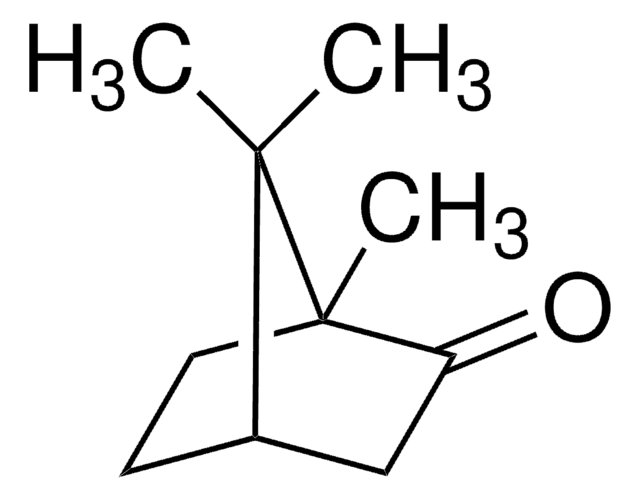等級
certified reference material
pharmaceutical secondary standard
品質等級
agency
traceable to Ph. Eur. C0405000
traceable to USP 1087508
蒸汽密度
5.24 (vs air)
蒸汽壓力
4 mmHg ( 70 °C)
API 家族
camphor
CofA
current certificate can be downloaded
自燃溫度
870 °F
expl. lim.
3.5 %
技術
HPLC: suitable
gas chromatography (GC): suitable
mp
178-182 °C (lit.)
應用
pharmaceutical (small molecule)
格式
neat
儲存溫度
2-8°C
SMILES 字串
CC1(C)[C@@H]2CC[C@@]1(C)C(=O)C2
InChI
1S/C10H16O/c1-9(2)7-4-5-10(9,3)8(11)6-7/h7H,4-6H2,1-3H3/t7-,10+/m1/s1
InChI 密鑰
DSSYKIVIOFKYAU-XCBNKYQSSA-N
尋找類似的產品? 前往 產品比較指南
相關類別
一般說明
Pharmaceutical secondary standards for application in quality control provide pharma laboratories and manufacturers with a convenient and cost-effective alternative to the preparation of in-house working standards. D-Camphor is an acyclic terpenoid and one of the key volatile constituents of essential oils of plants Artemisia tridenta, Mentha longifolia ssp., Longifolia and some Lamiaceae species.
應用
These Secondary Standards are qualified as Certified Reference Materials. These are suitable for use in several analytical applications including but not limited to pharma release testing, pharma method development for qualitative and quantitative analyses, food and beverage quality control testing, and other calibration requirements.
分析報告
These secondary standards offer multi-traceability to the USP, EP (PhEur) and BP primary standards, where they are available.
其他說明
This Certified Reference Material (CRM) is produced and certified in accordance with ISO 17034 and ISO/IEC 17025. All information regarding the use of this CRM can be found on the certificate of analysis.
腳註
To see an example of a Certificate of Analysis for this material enter LRAA8982 in the slot below. This is an example certificate only and may not be the lot that you receive.
相關產品
產品號碼
描述
訂價
訊號詞
Danger
危險分類
Acute Tox. 4 Inhalation - Eye Dam. 1 - Flam. Sol. 2 - Skin Irrit. 2 - STOT SE 2 Inhalation
標靶器官
Lungs
儲存類別代碼
4.1B - Flammable solid hazardous materials
水污染物質分類(WGK)
WGK 1
閃點(°F)
147.2 °F - closed cup
閃點(°C)
64 °C - closed cup
客戶也查看了
Jeffrey N Love et al.
The Journal of emergency medicine, 27(1), 49-54 (2004-06-29)
Serious pediatric toxicity resulting from exposure to small amounts of camphor-containing products has long been a problem. Twenty years ago the United States Food and Drug Administration took several actions in an attempt to ameliorate this risk. Despite these changes
E Siegel et al.
Pediatric clinics of North America, 33(2), 375-379 (1986-04-01)
Camphor is present in several over-the-counter compounds of questionable use and therefore may be ingested by small children. Because seizures may follow ingestion of certain amounts, appropriate treatment is needed, including the use of anticonvulsants.
Weiyang Chen et al.
Molecules (Basel, Switzerland), 18(5), 5434-5454 (2013-05-15)
The fragrant camphor tree (Cinnamomum camphora) and its products, such as camphor oil, have been coveted since ancient times. Having a rich history of traditional use, it was particularly used as a fumigant during the era of the Black Death
Gustav Georg Belz et al.
Phytomedicine : international journal of phytotherapy and phytopharmacology, 10 Suppl 4, 61-67 (2003-06-17)
Independent, double-blinded, randomized, placebo-controlled studies using sublingual/oral administration of D-camphor, an extract from fresh crataegus berries, and a combination of the two (CCC) yielded the following results: Both the D-camphor and the extract from fresh crataegus berries, the components of
Yali V Zhang et al.
Nature neuroscience, 16(10), 1468-1476 (2013-09-10)
Animals tend to reject bitter foods. However, long-term exposure to some unpalatable tastants increases acceptance of these foods. Here we show that dietary exposure to an unappealing but safe additive, camphor, caused the fruit fly Drosophila melanogaster to decrease camphor
我們的科學家團隊在所有研究領域都有豐富的經驗,包括生命科學、材料科學、化學合成、色譜、分析等.
聯絡技術服務







